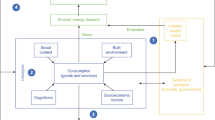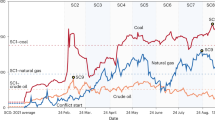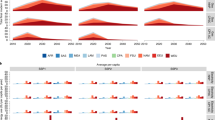Abstract
Techno-economic approaches largely avoid delineating necessary energy uses or questioning how excessive lifestyle expectations may curtail attempts to achieve ambitious climate change targets. In this Perspective, I present data suggesting a general trend of increasing domestic floor area per capita globally and argue that this ought to be a key focus in future energy research, considering that house size is the largest determinant of domestic energy consumption. Particular attention should be directed at the confluence of factors that influence floor area per capita and questions of lifestyle expectations, energy sufficiency and invisible energy policies that have enabled the rise in floor area per capita both deliberately and inadvertently. Overall, this elucidates why energy research must consider lifestyle expectations and demographic trends that are generally seen as outside the remit of energy policy.
This is a preview of subscription content, access via your institution
Access options
Access Nature and 54 other Nature Portfolio journals
Get Nature+, our best-value online-access subscription
$29.99 / 30 days
cancel any time
Subscribe to this journal
Receive 12 digital issues and online access to articles
$119.00 per year
only $9.92 per issue
Buy this article
- Purchase on Springer Link
- Instant access to full article PDF
Prices may be subject to local taxes which are calculated during checkout

Similar content being viewed by others
References
Shove, E. Beyond the ABC: climate change policy and theories of social change. Environ. Plan A 42, 1273–1285 (2010).
Royston, S., Selby, J. & Shove, E. Invisible energy policies: a new agenda for energy demand reduction. Energy Policy 123, 127–135 (2018).
Rosa, E. A. & Dietz, T. Human drivers of national greenhouse-gas emissions. Nat. Clim. Change 2, 581 (2012).
Peterson, M. N., Peterson, T. & Liu, J. The Housing Bomb: Why Our Addiction to Houses is Destroying the Environment and Threatening Our Society (JHU Press, 2013).
Lorek, S. & Spangenberg, J. H. Energy sufficiency through social innovation in housing. Energy Policy 126, 287–294 (2019).
Viggers, H., Keall, M., Wickens, K. & Howden-Chapman, P. Increased house size can cancel out the effect of improved insulation on overall heating energy requirements. Energy Policy 107, 248–257 (2017).
Bradbury, M., Peterson, M. N. & Liu, J. Long-term dynamics of household size and their environmental implications. Popul. Environ. 36, 73–84 (2014).
Liu, J., Daily, G. C., Ehrlich, P. R. & Luck, G. W. Effects of household dynamics on resource consumption and biodiversity. Nature 421, 530–533 (2003).
O’Neill, B. C. & Chen, B. S. Demographic determinants of household energy use in the United States. Popul. Dev. Rev. 28, 53–88 (2002).
Underwood, A. & Zahran, S. The carbon implications of declining household scale economies. Ecol. Econ. 116, 182–190 (2015).
Proportion of One-Person Households in All Households (United Nations Economic Commission for Europe, 2015); https://w3.unece.org/PXWeb/en/Charts?IndicatorCode=318&CountryCode=826
Fremstad, A., Underwood, A. & Zahran, S. The environmental impact of sharing: household and urban economies in CO2 emissions. Ecol. Econ. 145, 137–147 (2018).
Yates, L. Sharing, households and sustainable consumption. J. Consum. Cult. 18, 433–452 (2018).
Charmes, E. & Keil, R. The politics of post‐suburban densification in Canada and France. Int. J. Urban Reg. Res. 39, 581–602 (2015).
Wulff, M., Reynolds, M. & Healy, E. Why don’t small households live in small dwellings?: disentangling a planning dilemma. People Place 12, 58 (2004).
Dunham-Jones, E. & Williamson, J. Retrofitting Suburbia: Urban Design Solutions for Redesigning Suburbs (John Wiley & Sons, 2008).
Gray, R., Gleeson, B. & Burke, M. Urban consolidation, household greenhouse emissions and the role of planning. Urban Pol. Res. 28, 335–346 (2010).
Stephan, A., Crawford, R. H. & De Myttenaere, K. Multi-scale life cycle energy analysis of a low-density suburban neighbourhood in Melbourne, Australia. Build. Environ. 68, 35–49 (2013).
Dowling, R. & Power, E. Sizing home, doing family in Sydney, Australia. Hous. Stud. 27, 605–619 (2012).
Huebner, G. M. & Shipworth, D. All about size?–The potential of downsizing in reducing energy demand. Appl. Energy 186, 226–233 (2017).
Santin, O. G., Itard, L. & Visscher, H. The effect of occupancy and building characteristics on energy use for space and water heating in Dutch residential stock. Energy Build. 41, 1223–1232 (2009).
Huebner, G. M., Hamilton, I., Chalabi, Z., Shipworth, D. & Oreszczyn, T. Explaining domestic energy consumption–the comparative contribution of building factors, socio-demographics, behaviours and attitudes. Appl. Energy 159, 589–600 (2015).
Clune, S., Morrissey, J. & Moore, T. Size matters: house size and thermal efficiency as policy strategies to reduce net emissions of new developments. Energy Policy 48, 657–667 (2012).
Wilson, A. & Boehland, J. Small is beautiful US house size, resource use, and the environment. J. Ind. Ecol. 9, 277–287 (2005).
Renewables 2018 Global Status Report (Renewable Energy Policy Network for the 2st Century, 2018); http://www.ren21.net/wp-content/uploads/2018/06/17–8652_GSR2018_FullReport_web_final_.pdf
Tracking Clean Energy Progress 2017 (International Energy Agency, 2017); https://www.iea.org/publications/freepublications/publication/TrackingCleanEnergyProgress2017.pdf
Lesthaeghe, R. The second demographic transition: a concise overview of its development. Proc. Natl Acad. Sci. USA 111, 18112–18115 (2014).
Sobotka, T. Overview chapter 6: the diverse faces of the second demographic transition in Europe. Dem. Res. 19, 171–224 (2008).
Jamieson, L. & Simpson, R. Living alone: Globalization, Identity and Belonging (Springer, 2013).
Burch, T. K. & Matthews, B. J. Household formation in developed societies. Popul. Dev. Rev. 13, 495–511 (1987).
Albertini, M. & Kohli, M. The generational contract in the family: an analysis of transfer regimes in Europe. Eur. Sociol. Rev. 29, 828–840 (2012).
Living Arrangements of Older Persons Around the World (United Nations, 2005).
Palm, J. The public–private divide in household behavior: How far into home can energy guidance reach? Energy Policy 38, 2858–2864 (2010).
Sixsmith, J. et al. Healthy ageing and home: the perspectives of very old people in five European countries. Soc. Sci. Med. 106, 1–9 (2014).
Shove, E. Comfort, Cleanliness and Convenience (Berg, 2003).
Penfold, H., Waitt, G. & McGuirk, P. Portrayals of the tiny house in electronic media: challenging or reproducing the Australian dream home. Aust. Plan. 1–10 (2019).
Susanka, S. & Obolensky, K. The Not So Big House: A Blueprint for the Way We Really Live (Taunton Press, 2001).
Ellsworth-Krebs, K., Reid, L. & Hunter, C. J. Home-ing in on domestic energy research: “House, ” “home, ” and the importance of ontology. Energy Res. Soc. Sci. 6, 100–108 (2015).
Ellsworth-Krebs, K., Reid, L. & Hunter, C. J. Integrated framework of home comfort: relaxation, companionship and control. Build. Res. Inf. 47, 202–218 (2019).
Better Life Index: Housing (The Organisation for Economic Co-operation and Development, 2019); http://www.oecdbetterlifeindex.org/topics/housing/
What Home Buyers Want: Attitudes and Decision Making Among Consumers (Commission for Architecture & the Built Environment, 2005)
Construction and the Environment, Yearbook of Australia (Australian Bureau of Statistics, 2013); http://www.abs.gov.au/AUSSTATS/abs@.nsf/Previousproducts/1301.0Feature%20Article282003
Building Activity Survey, Total New Residential/Census Average Number of Person Per household (Australian Bureau of Statistics, 2013); http://www.abs.gov.au/AUSSTATS/abs@.nsf/Previousproducts/8752.0Feature%20Article1Jun%202013
Cambodia Socioeconomic Survey 2004 (National Institute of Statistics, Ministry of Planning, Royal Kingdom of Cambodia, 2004); http://www.nis.gov.kh/index.php/en/national-statistical-systems/official-statistics-of-cambodia/14-cses/39-cses-2004-report
Cambodia Socioeconomic Survey 2007 (National Institute of Statistics, Ministry of Planning, Royal Kingdom of Cambodia, 2007; http://www.nis.gov.kh/nis/CSES/NIS_CSES_Report_Housing_final200809.pdf
Cambodia Socioeconomic Survey 2009 (National Institute of Statistics, Ministry of Planning, Royal Kingdom of Cambodia, 2009); http://www.nis.gov.kh/nis/CSES/Final%20Report%20CSES%202009.pdf
Cambodia Socioeconomic Survey 2010 (National Institute of Statistics, Ministry of Planning, Royal Kingdom of Cambodia, 2010); http://www.nis.gov.kh/nis/CSES/Final%20Report%20CSES%202010.pdf
Cambodia Socioeconomic Survey 2012 (National Institute of Statistics, Ministry of Planning, Royal Kingdom of Cambodia, 2012); http://www.nis.gov.kh/nis/CSES/Final%20Report%20CSES%202012.pdf
Cambodia Socioeconomic Survey 2013 (National Institute of Statistics, Ministry of Planning, Royal Kingdom of Cambodia, 2013); http://www.nis.gov.kh/nis/CSES/Final%20Report%20CSES%202013.pdf
Cambodia Socioeconomic Survey 2014 (National Institute of Statistics, Ministry of Planning, Royal Kingdom of Cambodia, 2014); http://www.nis.gov.kh/nis/CSES/Final%20Report%20CSES%202014.pdf
Cambodia Socioeconomic Survey 2015 (National Institute of Statistics, Ministry of Planning, Royal Kingdom of Cambodia, 2015); http://www.nis.gov.kh/nis/CSES/Final%20Report%20CSES%202015.pdf
Cambodia Socioeconomic Survey 2016 (National Institute of Statistics, Ministry of Planning, Royal Kingdom of Cambodia, 2016); http://www.nis.gov.kh/nis/CSES/Final%20Report%20CSES%202016.pdf
Cambodia Socioeconomic Survey 2017 (National Institute of Statistics, Ministry of Planning, Royal Kingdom of Cambodia, 2017); http://www.nis.gov.kh/nis/CSES/Final%20Report%20CSES%202017.pdf
Floor Space of Newly Built Residential Buildings (National Bureau of Statistics of China, 2014); Available at: http://www.stats.gov.cn/tjsj/ndsj/2014/zk/html/Z0617E.htm
Dwellings with registered population (average) by Area, Unit, and Use (StatBank Denmark, 2018); https://www.statbank.dk/statbank5a/selectvarval/define.asp?PLanguage=1&subword=tabsel&MainTable=BOL106&PXSId=206367&tablestyle=&ST=SD&buttons=0
Noll, H.-H. & Weick, S. Housing in Germany: Expensive, Comfortable and Usually Rented (Informationsdienst Soziale Indikatoren - ISI selected English articles, 2014); https://www.gesis.org/fileadmin/upload/forschung/publikationen/zeitschriften/isi/isi41-NollWeick-English.pdf
Housing in Figures 1995 (Hong Kong Housing Authority, 1995); http://www.cityu.edu.hk/hkhousing/hs/figures/HIF_1995_part_1.pdf
Housing in Figures 1996 (Hong Kong Housing Authority, 1996); http://www.cityu.edu.hk/hkhousing/hs/figures/HIF_1996_part_2.pdf
Housing in Figures 1997 (Hong Kong Housing Authority, 1997); http://www.cityu.edu.hk/hkhousing/hs/figures/HIF_1997_part_2.pdf
Housing in Figures 1998 (Hong Kong Housing Authority, 1998); http://www.cityu.edu.hk/hkhousing/hs/figures/HIF_1998_part_1.pdf
Housing in Figures 1999 (Hong Kong Housing Authority, 1999); http://www.cityu.edu.hk/hkhousing/hs/figures/HIF_1999_part_1.pdf
Housing in Figures 2010 (Hong Kong Housing Authority, 2010); http://www.cityu.edu.hk/hkhousing/hs/figures/Housing_in_Figures_2010_c.pdf
Housing in Figures 2011 (Hong Kong Housing Authority, 2011); http://www.cityu.edu.hk/hkhousing/hs/figures/Housing_in_Figures_2011_c.pdf
Housing in Figures 2012 (Hong Kong Housing Authority, 2012); http://www.cityu.edu.hk/hkhousing/hs/figures/Housing_in_Figures_2012_c.pdf
Housing in Figures 2013 (Hong Kong Housing Authority, 2013); http://www.cityu.edu.hk/hkhousing/hs/figures/Housing_in_Figures_2013_c.pdf
Housing in Figures 2014 (Hong Kong Housing Authority, 2014); http://www.cityu.edu.hk/hkhousing/hs/figures/Housing_in_Figures_2014_c.pdf
Housing in Figures 2015 (Hong Kong Housing Authority, 2015); http://www.cityu.edu.hk/hkhousing/hs/figures/Housing_in_Figures_2015_c.pdf
Housing in Figures 2018 (Hong Kong Housing Authority, 2018); https://www.thb.gov.hk/tc/psp/publications/housing/HIF2018.pdf
The National Sample Survey, August 1956-January 1957 (Indian Statistical Institute, the Cabinet Secretariat: Government of India, 1961); http://www.mospi.nic.in/sites/default/files/publication_reports/nss_rep_51.pdf
State of Housing in India, A Statistical Compendium (National Buildings Organisation, Government of India, 2013); http://nbo.nic.in/Images/PDF/Housing_in_India_Compendium_English_Version.pdf
Households, Household Members and Size of Dwelling by Prefecture, Housing 21–1, Japan Statistical Yearbook 2016 (Statistics Bureau, Ministry of Internal Affairs and Communications, 2016). Available at: http://www.stat.go.jp/english/data/nenkan/65nenkan/1431–21html
Construction activity and housing provision in Russia (translated from Russian). Rosttat, Federal States Statistic Service http://rusfact.ru/node/28 (2017).
Housing living situation by year (translated from Mandarin Chinese). National Statistics, Directorate General of Budget, Accounting and Statistics http://statdb.dgbas.gov.tw/pxweb/dialog/..%5CDialog%5Cviewplus.asp?ma=FF0008A1A&ti=%AEa%AEx%A6%ED%A6v%AA%AC%AAp%20%20-%A6~&path=../PXfile/HouseholdFinances/&lang=9&strList=L (2016).
English House Condition Survey 2003 Annual Report (Office of the Deputy Prime Minister, 2003).; http://doc.ukdataservice.ac.uk/doc/6103/mrdoc/pdf/6103annual_report.pdf
English House Condition Survey 2004 Annual Report (Office of the Deputy Prime Minister, 2004); http://doc.ukdataservice.ac.uk/doc/6104/mrdoc/pdf/6104annual_report.pdf
English House Condition Survey 1996 Summary (Department for Communities and Local Government, 2006); http://doc.ukdataservice.ac.uk/doc/6101/mrdoc/pdf/6101ehcs_1996_summary.pdf
English House Condition Survey 2007 Annual Report (Department for Communities and Local Government, 2007); http://doc.ukdataservice.ac.uk/doc/6449/mrdoc/pdf/6449ehcs_annual_report_2007.pdf
English Housing Survey, Headline report 2009–10 (Department of Communities and Local Government, 2011); http://doc.ukdataservice.ac.uk/doc/6804/mrdoc/pdf/6804ehs_headline_report_2009_10.pdf
English Housing Survey, Headline report 2010–11 (Department of Communities and Local Government, 2012); http://doc.ukdataservice.ac.uk/doc/7039/mrdoc/pdf/7039_ehs_headline_report_2010–11pdf
English Housing Survey, Headline report 2012–13 (Department of Communities and Local Government, 2014); http://doc.ukdataservice.ac.uk/doc/7511/mrdoc/pdf/7511_ehs_headline_report_2012–13pdf
English Housing Survey, Headline report 2013–14 (Department of Communities and Local Government, 2015); http://doc.ukdataservice.ac.uk/doc/7802/mrdoc/pdf/7802_english_housing_survey_headline_report_2013–14pdf
English Housing Survey, Headline report 2014–15 (Department of Communities and Local Government, 2016); http://doc.ukdataservice.ac.uk/doc/8009/mrdoc/pdf/8009_ehs_headline_report_2014–15pdf
English Housing Survey, Headline report 2015–16 (Department of Communities and Local Government, 2017); http://doc.ukdataservice.ac.uk/doc/8185/mrdoc/pdf/8185_2015–16_ehs_headline_report.pdf
English Housing Survey, Headline report 2015–16 (Department of Communities and Local Government, 2018); http://doc.ukdataservice.ac.uk/doc/8350/mrdoc/pdf/8350_2016–17_ehs_headline_report.pdf
American Housing Survey for the United States in 1993 (US Census Bureau, 1995); https://www.census.gov/content/dam/Census/library/publications/1995/demo/h150_93.pdf
American Housing Survey for the United States in 1995 (US Census Bureau, 1997); https://www.census.gov/content/dam/Census/library/publications/1997/demo/h150_95rv.pdf
American Housing Survey for the United States in 1997 (US Census Bureau, 2000); https://www.census.gov/prod/99pubs/h150–97pdf
American Housing Survey for the United States in 2001 (US Census Bureau, 2002); https://www.census.gov/prod/2002pubs/h150–01pdf
American Housing Survey for the United States in 1999 (US Census Bureau, 2003); https://www.census.gov/content/dam/Census/programs-surveys/ahs/data/1999/h150–99pdf
American Housing Survey for the United States in 2003 (US Census Bureau, 2004); https://www.census.gov/prod/2004pubs/H150–03pdf
American Housing Survey for the United States in 2005 (US Census Bureau, 2006); https://www.census.gov/prod/2006pubs/h150–05pdf
American Housing Survey for the United States in 2007 (US Census Bureau, 2008); https://www.census.gov/prod/2008pubs/h150–07pdf
American Housing Survey for the United States in 2009 (US Census Bureau, 2011); https://www.census.gov/prod/2011pubs/h150–09pdf
American Housing Survey for the United States, Table Generator (US Census Bureau, 2019); https://www.census.gov/prod/2011pubs/h150–09pdf
Vietnam Housing Sector Profile (United National Habitat for a Better Urban Future, 2013); https://unhabitat.org/vietnam-housing-sector-profile/.
Result of the Viet Nam Household Living Standards Survey 2006 (General Statistics Office of Viet Nam, 2006); https://www.gso.gov.vn/default_en.aspx?tabid=515&idmid=5&ItemID=8183
Result of the Survey on Household Living Standards 2008 (General Statistics Office of Viet Nam, 2008); https://www.gso.gov.vn/default_en.aspx?tabid=515&idmid=5&ItemID=9647
Result of the Viet Nam Household Living Standards Survey 2010 (General Statistics Office of Viet Nam, 2010); https://www.gso.gov.vn/default_en.aspx?tabid=515&idmid=5&ItemID=12426
Result of the Viet Nam Household Living Standards Survey 2012 (General Statistics Office of Viet Nam, 2012); https://www.gso.gov.vn/default_en.aspx?tabid=483&idmid=4&ItemID=13888
Result of the Viet Nam Household Living Standards Survey 2014 (General Statistics Office of Viet Nam, 2014); http://www.gso.gov.vn/default.aspx?tabid=512&idmid=&ItemID=18410
Result of the Viet Nam Household Living Standards Survey 2016. (General Statistics Office of Viet Nam, 2016). Available at: https://www.gso.gov.vn/default_en.aspx?tabid=515&idmid=5&ItemID=18977
Acknowledgements
I am thankful to B. Kao, K. Stewart and N. Joubert for their support in finding government data sources (in different languages) on floor area per capita and to L. Jamieson (University of Edinburgh), T. Moore (Royal Melbourne Institute of Technology University) and K. Keenan (University of St Andrews) for their helpful comments. This research was made possible by a Carnegie Trust Research Incentive Grant (Grant no. RIG007515).
Author information
Authors and Affiliations
Corresponding author
Ethics declarations
Competing interests
The author declares no competing interests.
Additional information
Publisher’s note Springer Nature remains neutral with regard to jurisdictional claims in published maps and institutional affiliations.
Source data
Source Data Fig. 1
Supplementary information for Fig. 1
Rights and permissions
About this article
Cite this article
Ellsworth-Krebs, K. Implications of declining household sizes and expectations of home comfort for domestic energy demand. Nat Energy 5, 20–25 (2020). https://doi.org/10.1038/s41560-019-0512-1
Received:
Accepted:
Published:
Issue Date:
DOI: https://doi.org/10.1038/s41560-019-0512-1
This article is cited by
-
Decarbonization pathways for the residential sector in the United States
Nature Climate Change (2022)
-
Obstacles and opportunities for reducing dwelling size to shrink the environmental footprint of housing: tenants’ residential preferences and housing choice
Journal of Housing and the Built Environment (2022)
-
Can ‘Sufficiency’ reconcile social and environmental goals? A Q-methodological analysis of German housing policy
Journal of Housing and the Built Environment (2021)



